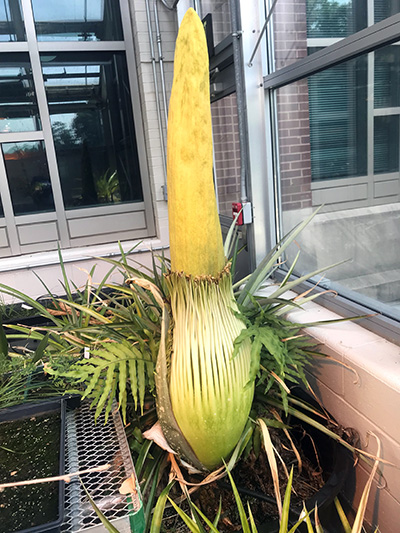- Apply
- Visit
- Request Info
- Give
What’s that smell? Corpse flower blooms at Eastern
Written by Michael Rouleau
Published on July 27, 2022
One of the world’s most peculiar flowering plants bloomed this week at Eastern Connecticut State University. Amorphophallus titanium, popularly known as “corpse flower” for its unmistakably putrid odor, completed its short-lived, semiannual bloom in the greenhouse of the David G. Carter Science Building.
Native to the Indonesian island of Sumatra, corpse flower is the world’s largest unbranched inflorescence—a group of flowers arranged on a stem—reaching heights up to 12 feet tall. According to Biology Professor Bryan Connolly, the plant wreaks of feces and rotting fish to attract pollinators that normally feed and lay eggs on dead animals.

A corpse flower’s first bloom may take up to 10 years and last just three days. Under ideal conditions, subsequent blooms may occur ever second or third year. Corpse flowers are rare in their native jungle environment; therefore the flowers’ powerful odor is necessary to facilitate cross pollination between plants that are miles apart.
Eastern’s greenhouse contains two genetic individuals and several clones of corpse flower. Retired Biology Professor Ross Koning first brought the seeds to campus in 1999. “One was grown in shade and bloomed in 2008,” said Connolly. “He (Koning) named it ‘Rhea’ after the Titan mother goddess, as it spawned many cormels (clones). The other seed was grown in sun and he named it ‘Hyperion’ after the sun-Titan god.”
Corpse flower is self-incompatible; it needs another blooming individual to reproduce. According to Connolly, it is uncommon for a greenhouse or botanical garden to have multiple individuals in bloom simultaneously, therefore they often send pollen to each other to produce seed.
The species is considered endangered by the International Union for the Conservation of Nature (IUCN) and efforts are underway to avoid inbreeding and create long-term conservation.


